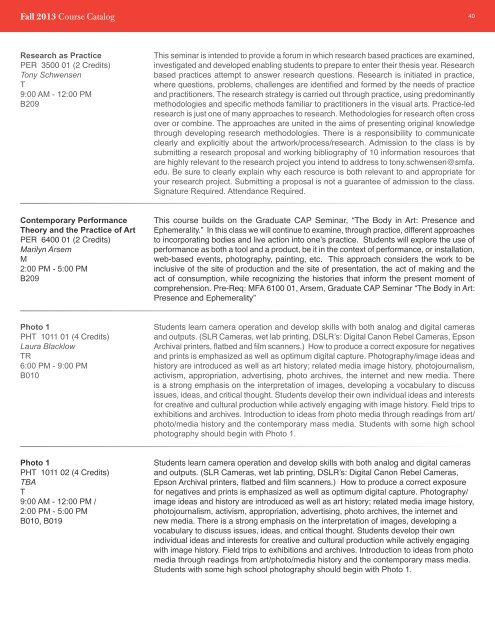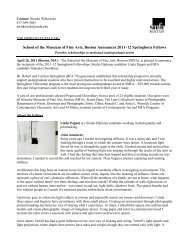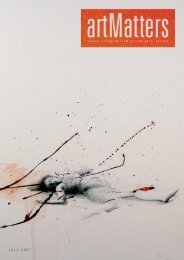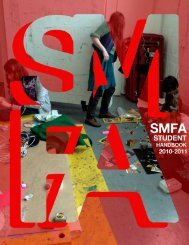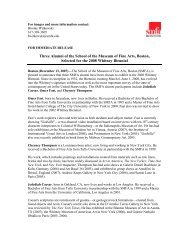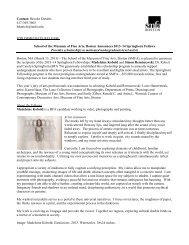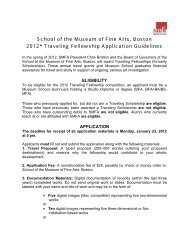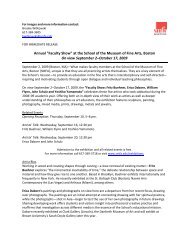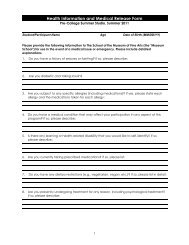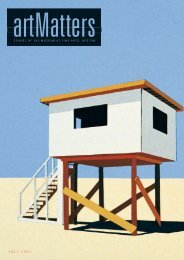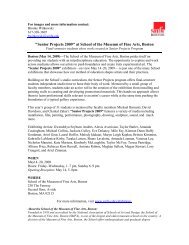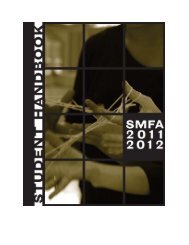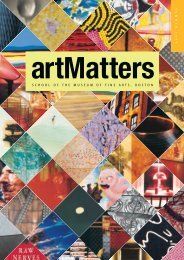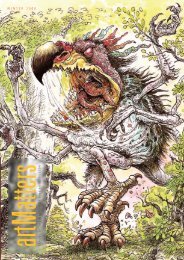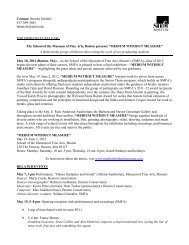Fall 2013 Course Catalog - School of the Museum of Fine Arts
Fall 2013 Course Catalog - School of the Museum of Fine Arts
Fall 2013 Course Catalog - School of the Museum of Fine Arts
Create successful ePaper yourself
Turn your PDF publications into a flip-book with our unique Google optimized e-Paper software.
<strong>Fall</strong> <strong>2013</strong> <strong>Course</strong> <strong>Catalog</strong><br />
40<br />
Research as Practice<br />
PER 3500 01 (2 Credits)<br />
Tony Schwensen<br />
T<br />
9:00 AM - 12:00 PM<br />
B209<br />
This seminar is intended to provide a forum in which research based practices are examined,<br />
investigated and developed enabling students to prepare to enter <strong>the</strong>ir <strong>the</strong>sis year. Research<br />
based practices attempt to answer research questions. Research is initiated in practice,<br />
where questions, problems, challenges are identified and formed by <strong>the</strong> needs <strong>of</strong> practice<br />
and practitioners. The research strategy is carried out through practice, using predominantly<br />
methodologies and specific methods familiar to practitioners in <strong>the</strong> visual arts. Practice-led<br />
research is just one <strong>of</strong> many approaches to research. Methodologies for research <strong>of</strong>ten cross<br />
over or combine. The approaches are united in <strong>the</strong> aims <strong>of</strong> presenting original knowledge<br />
through developing research methodologies. There is a responsibility to communicate<br />
clearly and explicitly about <strong>the</strong> artwork/process/research. Admission to <strong>the</strong> class is by<br />
submitting a research proposal and working bibliography <strong>of</strong> 10 information resources that<br />
are highly relevant to <strong>the</strong> research project you intend to address to tony.schwensen@smfa.<br />
edu. Be sure to clearly explain why each resource is both relevant to and appropriate for<br />
your research project. Submitting a proposal is not a guarantee <strong>of</strong> admission to <strong>the</strong> class.<br />
Signature Required. Attendance Required.<br />
Contemporary Performance<br />
Theory and <strong>the</strong> Practice <strong>of</strong> Art<br />
PER 6400 01 (2 Credits)<br />
Marilyn Arsem<br />
M<br />
2:00 PM - 5:00 PM<br />
B209<br />
This course builds on <strong>the</strong> Graduate CAP Seminar, “The Body in Art: Presence and<br />
Ephemerality.” In this class we will continue to examine, through practice, different approaches<br />
to incorporating bodies and live action into one’s practice. Students will explore <strong>the</strong> use <strong>of</strong><br />
performance as both a tool and a product, be it in <strong>the</strong> context <strong>of</strong> performance, or installation,<br />
web-based events, photography, painting, etc. This approach considers <strong>the</strong> work to be<br />
inclusive <strong>of</strong> <strong>the</strong> site <strong>of</strong> production and <strong>the</strong> site <strong>of</strong> presentation, <strong>the</strong> act <strong>of</strong> making and <strong>the</strong><br />
act <strong>of</strong> consumption, while recognizing <strong>the</strong> histories that inform <strong>the</strong> present moment <strong>of</strong><br />
comprehension. Pre-Req: MFA 6100 01, Arsem, Graduate CAP Seminar “The Body in Art:<br />
Presence and Ephemerality”<br />
Photo 1<br />
PHT 1011 01 (4 Credits)<br />
Laura Blacklow<br />
TR<br />
6:00 PM - 9:00 PM<br />
B010<br />
Students learn camera operation and develop skills with both analog and digital cameras<br />
and outputs. (SLR Cameras, wet lab printing, DSLR’s: Digital Canon Rebel Cameras, Epson<br />
Archival printers, flatbed and film scanners.) How to produce a correct exposure for negatives<br />
and prints is emphasized as well as optimum digital capture. Photography/image ideas and<br />
history are introduced as well as art history; related media image history, photojournalism,<br />
activism, appropriation, advertising, photo archives, <strong>the</strong> internet and new media. There<br />
is a strong emphasis on <strong>the</strong> interpretation <strong>of</strong> images, developing a vocabulary to discuss<br />
issues, ideas, and critical thought. Students develop <strong>the</strong>ir own individual ideas and interests<br />
for creative and cultural production while actively engaging with image history. Field trips to<br />
exhibitions and archives. Introduction to ideas from photo media through readings from art/<br />
photo/media history and <strong>the</strong> contemporary mass media. Students with some high school<br />
photography should begin with Photo 1.<br />
Photo 1<br />
PHT 1011 02 (4 Credits)<br />
TBA<br />
T<br />
9:00 AM - 12:00 PM /<br />
2:00 PM - 5:00 PM<br />
B010, B019<br />
Students learn camera operation and develop skills with both analog and digital cameras<br />
and outputs. (SLR Cameras, wet lab printing, DSLR’s: Digital Canon Rebel Cameras,<br />
Epson Archival printers, flatbed and film scanners.) How to produce a correct exposure<br />
for negatives and prints is emphasized as well as optimum digital capture. Photography/<br />
image ideas and history are introduced as well as art history; related media image history,<br />
photojournalism, activism, appropriation, advertising, photo archives, <strong>the</strong> internet and<br />
new media. There is a strong emphasis on <strong>the</strong> interpretation <strong>of</strong> images, developing a<br />
vocabulary to discuss issues, ideas, and critical thought. Students develop <strong>the</strong>ir own<br />
individual ideas and interests for creative and cultural production while actively engaging<br />
with image history. Field trips to exhibitions and archives. Introduction to ideas from photo<br />
media through readings from art/photo/media history and <strong>the</strong> contemporary mass media.<br />
Students with some high school photography should begin with Photo 1.


